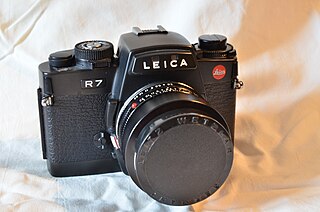Related Research Articles

A single-lens reflex camera (SLR) is a camera that typically uses a mirror and prism system that permits the photographer to view through the lens and see exactly what will be captured. With twin lens reflex and rangefinder cameras, the viewed image could be significantly different from the final image. When the shutter button is pressed on most SLRs, the mirror flips out of the light path, allowing light to pass through to the light receptor and the image to be captured.

Minolta Co., Ltd. was a Japanese manufacturer of cameras, camera accessories, photocopiers, fax machines, and laser printers. Minolta Co., Ltd., which is also known simply as Minolta, was founded in Osaka, Japan, in 1928 as Nichi-Doku Shashinki Shōten. It made the first integrated autofocus 35 mm SLR camera system. In 1931, the company adopted its final name, an acronym for "Mechanism, Instruments, Optics, and Lenses by Tashima".

The Nikon F6 is a 35 mm film single-lens reflex camera body manufactured by Nikon between 2004 and 2020. It was the sixth film camera in Nikon's 35mm F-series SLR line-up. Designed by Nikon, the model was manufactured at their Sendai plant.

A point-and-shoot camera, also known as a compact camera and sometimes abbreviated to P&S, is a still camera designed primarily for simple operation. Most use focus free lenses or autofocus for focusing, automatic systems for setting the exposure options, and have flash units built in. They are popular for vernacular photography by people who do not consider themselves photographers but want easy-to-use cameras for snapshots of vacations, parties, reunions and other events.

The Nikon F-801 is a 35mm SLR released worldwide in June 1988 and manufactured until 1991, when it was replaced by the improved Nikon F-801s, which in turn was discontinued in early 1995. Although its autofocus mechanism is slow in comparison to modern standards, it was an improvement on Nikon's first attempt at an autofocus SLR - the F-501, and proved to be reliable and durable, typical of Nikon's cameras.

The Pentax Auto 110 and Pentax Auto 110 Super were fully automatic single-lens reflex cameras manufactured by Asahi Pentax for use with Kodak 110 film cartridges. The Auto 110 was introduced with three interchangeable, fixed focal length lenses in 1978. A further three lenses were added in 1981 to coincide with the release of the Auto 110 Super the following year. The camera system was sold until 1985. The complete system is sometimes known as the Pentax System 10, apparently for its official Pentax name, although most Pentax advertising only uses the camera name or Pentax-110. This model represented the only complete ultraminiature SLR system manufactured for the 110 film format, although several fixed-lens 110 SLRs were sold. The camera system also claims to be the smallest interchangeable-lens SLR system ever created.
The Olympus AZ-4 Zoom is a 35mm fixed-lens SLR camera introduced in 1989.

The Nikon F4 is a 35 mm autofocus (AF) single lens reflex (SLR) film camera, introduced in 1988 as the next generation in Nikon's line of F series professional cameras. With industrial design by Giorgetto Giugiaro, the F4 was the first professional Nikon to feature a practical autofocus system. The F4 is able to accept any of Nikon's manual focus (MF) or AF lenses from 1959 to the present day, including the two F3AF lenses. The F4 succeeded the F3, a manual focus camera introduced in 1980 but outlasting the F4 as it stayed in production until 2001. Nikon introduced its next flagship model, the F5, in 1996. All F4 models were discontinued soon after, in May 1997.

The Nikon FE is an advanced semi-professional level, interchangeable lens, 35 mm film, single-lens reflex (SLR) camera. It was manufactured by Nikon in Japan from 1978 to 1983, and was available new from dealer stock until c. 1984. The FE uses a metal-bladed, vertical-travel focal plane shutter with a speed range of 8 to 1/1000 second, plus Bulb, and flash X-sync of 1/125th second. It had dimensions of 89.5 millimetres (3.52 in) height, 142 mm (5.6 in) width, 57.5 mm (2.26 in) depth and 590 grams (21 oz) weight. It was available in two colors: black with chrome trim and all black. As on the FM, its model designation did not appear on the front of the camera, but was engraved as a small "FE" preceding the serial number on the rear of the housing.

The Nikon EM is a beginner's level, interchangeable lens, 35 mm film, single lens reflex (SLR) camera. It was manufactured by Nippon Kogaku K. K. in Japan from 1979 to 1982. The camera was designed for and marketed to the growing market of new photographers then entering the SLR buyer's market. The EM uses a Seiko MFC-E focal plane shutter with a speed range of 1 to 1/1000 second plus Bulb and flash X-sync of 1/90 second. It is 86 mm (3.4 in) high, 135 mm (5.3 in) wide, 54 mm (2.1 in) deep and weighed 460 grams (16 oz). Unlike most Nikons of the time, it was available only in black. The EM has no full manual exposure mode capability, but instead was intended to be used by inexperienced photographers who could not easily master the intricacies of shutter speeds and f-stops. There were also significant changes to the EM's mechanical and electrical components to reduce its production cost relative to previous Nikon cameras: dimensional tolerances weren't as tight, there were no ball bearings in the film advance mechanism, and no high-quality titanium shutter. The introductory US list price for the body plus normal lens was only $231.

The Nikon FG is an interchangeable lens, 35 mm film, single-lens reflex (SLR) camera. It was manufactured by Nippon Kogaku K. K. in Japan from 1982 to 1986.

The Nikon F-501 was the first successful autofocus SLR camera sold by the Nikon Corporation beginning in 1986. A nearly identical, albeit manual focus version, called the Nikon F-301 was also available. Subsequent models in the consumer line included the Nikon F-401, Nikon F-601, and Nikon F-801 / F-801s.
The Olympus OM System was a line of 35mm single-lens reflex cameras, lenses and accessories sold by Olympus between 1972 and 2002. The system was introduced by Olympus in 1972. The range was designed by Yoshihisa Maitani, chief designer for Olympus, and his staff; OM stands for Olympus Maitani.

The history of the single-lens reflex camera (SLR) begins with the use of a reflex mirror in a camera obscura described in 1676, but it took a long time for the design to succeed for photographic cameras. The first patent was granted in 1861, and the first cameras were produced in 1884, but while elegantly simple in concept, they were very complex in practice. One by one these complexities were overcome as optical and mechanical technology advanced, and in the 1960s the SLR camera became the preferred design for many high-end camera formats.

Chinon Industries Inc. was a Japanese camera manufacturer. Kodak took a majority stake in the company in 1997, and made it a fully owned subsidiary of Kodak Japan, Kodak Digital Product Center, Japan Ltd., in 2004. As a subsidiary, it continues to develop digital camera models.

The Minolta A-mount camera system was a line of photographic equipment from Minolta introduced in 1985 with the world's first integrated autofocus system in the camera body with interchangeable lenses. The system used a lens mount called A-mount, with a flange focal distance 44.50 mm, one millimeter longer, 43.5 mm, than the previous SR mount from 1958. The new mount was wider, 49.7 mm vs. 44.97 mm, than the older SR-mount and due to the longer flange focal distance, old manual lenses were incompatible with the new system. Minolta bought the autofocus technology of Leica Correfot camera which was partly used on the a-mount autofocus technology. The mount is now used by Sony, who bought the SLR camera division from Konica Minolta, Konica and Minolta having merged a few years before.

The Pentax ME F was an amateur level, interchangeable lens, 35 mm film, single-lens reflex (SLR) camera. It was manufactured by Asahi Optical Co., Ltd. of Japan from November 1981 to 1984. The ME F was a heavily modified version of the Pentax ME-Super, and a member of the Pentax M-series family of SLRs. It was the first mass-produced SLR camera to come with an autofocus system.

The Minolta 9000 AF is a professional Single-lens reflex autofocus camera, introduced by Minolta in August 1985. It was both Minolta's and the world's first professional autofocus SLR. It was called Minolta Maxxum 9000 in the US and Minolta α-9000 in Japan.
This article discusses the cameras – mainly 35 mm SLRs – manufactured by Pentax Ricoh Imaging Corp. and its predecessors, Pentax Corporation and Asahi Optical Co., Ltd.. Pentax must not be confused with Pentax 6x7 or Pentax 67 which are 120 medium format 6x7cm film cameras.

Leica R4, R5, R6, R7 were 35 mm SLR cameras manufactured by Leica between 1980 and 1997 and belonged to the manual focusing R-System, which was offered from 1965 to 2009.